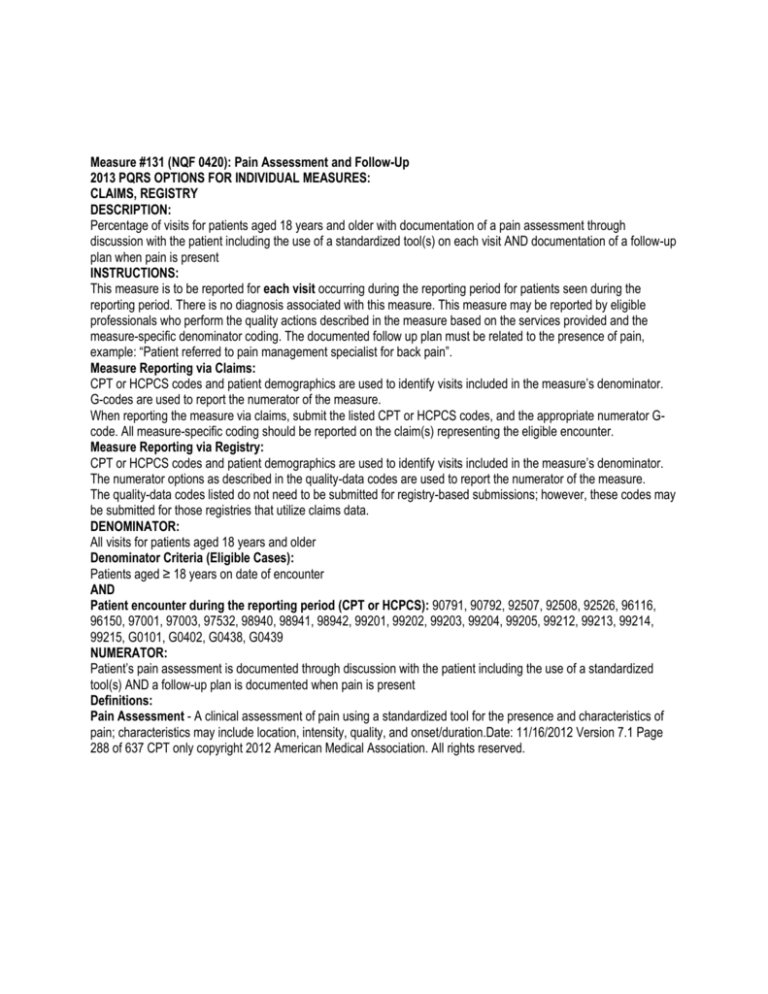
Measure #131 (NQF 0420): Pain Assessment and Follow-Up
2013 PQRS OPTIONS FOR INDIVIDUAL MEASURES:
CLAIMS, REGISTRY
DESCRIPTION:
Percentage of visits for patients aged 18 years and older with documentation of a pain assessment through
discussion with the patient including the use of a standardized tool(s) on each visit AND documentation of a follow-up
plan when pain is present
INSTRUCTIONS:
This measure is to be reported for each visit occurring during the reporting period for patients seen during the
reporting period. There is no diagnosis associated with this measure. This measure may be reported by eligible
professionals who perform the quality actions described in the measure based on the services provided and the
measure-specific denominator coding. The documented follow up plan must be related to the presence of pain,
example: “Patient referred to pain management specialist for back pain”.
Measure Reporting via Claims:
CPT or HCPCS codes and patient demographics are used to identify visits included in the measure’s denominator.
G-codes are used to report the numerator of the measure.
When reporting the measure via claims, submit the listed CPT or HCPCS codes, and the appropriate numerator Gcode. All measure-specific coding should be reported on the claim(s) representing the eligible encounter.
Measure Reporting via Registry:
CPT or HCPCS codes and patient demographics are used to identify visits included in the measure’s denominator.
The numerator options as described in the quality-data codes are used to report the numerator of the measure.
The quality-data codes listed do not need to be submitted for registry-based submissions; however, these codes may
be submitted for those registries that utilize claims data.
DENOMINATOR:
All visits for patients aged 18 years and older
Denominator Criteria (Eligible Cases):
Patients aged ≥ 18 years on date of encounter
AND
Patient encounter during the reporting period (CPT or HCPCS): 90791, 90792, 92507, 92508, 92526, 96116,
96150, 97001, 97003, 97532, 98940, 98941, 98942, 99201, 99202, 99203, 99204, 99205, 99212, 99213, 99214,
99215, G0101, G0402, G0438, G0439
NUMERATOR:
Patient’s pain assessment is documented through discussion with the patient including the use of a standardized
tool(s) AND a follow-up plan is documented when pain is present
Definitions:
Pain Assessment - A clinical assessment of pain using a standardized tool for the presence and characteristics of
pain; characteristics may include location, intensity, quality, and onset/duration.Date: 11/16/2012 Version 7.1 Page
288 of 637 CPT only copyright 2012 American Medical Association. All rights reserved.
Standardized Tool – An assessment tool that has been appropriately normalized and validated for the population in
which it is used. Examples of tools for pain assessment, include, but are not limited to: Brief Pain Inventory (BPI),
Faces Pain Scale (FPS), McGill Pain Questionnaire (MPQ), Multidimensional Pain Inventory (MPI), Neuropathic Pain
Scale (NPS), Numeric Rating Scale (NRS), Oswestry Disability Index (ODI), Roland Morris Disability Questionnaire
(RMDQ), Verbal Descriptor Scale (VDS), Verbal Numeric Rating Scale (VNRS), and Visual Analog Scale (VAS).
Follow-Up Plan – Proposed outline of treatment to be conducted as a result of pain assessment. Follow-up must
include a planned reassessment of pain and may include documentation of future appointments, education, referrals,
pharmacological intervention, or notification of other care providers as applicable.
Not Eligible – A patient is not eligible if one or more of the following reasons exist:
• Severe mental and/or physical incapacity where the person is unable to express himself/herself in a manner
understood by others. For example, cases where pain cannot be accurately assessed through use of nationally
recognized standardized pain assessment tools.
• Patient is in an urgent or emergent situation where time is of the essence and to delay treatment would jeopardize
the patient’s health status.
Numerator Quality-Data Coding Options for Reporting Satisfactorily:
Pain Assessment Documented as Positive AND Follow-Up Plan Documented
(One G-code [G873x] is required on the claim form to submit this numerator option)
G8730: Pain assessment documented as positive utilizing a standardized tool AND a follow-up plan is documented
OR
Pain Assessment Documented as Negative, No Follow-Up Plan Required
G8731: Pain assessment documented as negative, no follow-up plan required
OR
Patient not Eligible for Pain Assessment for Documented Reasons
(One G-code [G8442 or G8939] is required on the claim form to submit this numerator option)
G8442: Documentation that patient is not eligible for a pain assessment
OR
Pain Assessment Documented, Follow-Up Plan not Documented, Patient not Eligible/Appropriate
G8939: Pain assessment documented, follow-up plan not documented, patient not eligible/appropriate
OR
Pain Assessment not Documented, Reason not Given
(One G-code [G87xx] is required on the claim form to submit this numerator option)
G8732: No documentation of pain assessment, reason not given
OR
Pain Assessment Documented as Positive, Follow-Up Plan not Documented, Reason not Given
G8509: Documentation of positive pain assessment; no documentation of a follow-up plan, reason not given
RATIONALE:
Several provisions from the National Pain Care Policy Act (H.R. 756/S. 660) have been included in the Affordable
Care Act (ACA) of 2010 to improve pain care. The legislation includes:
• Mandating an Institute of Medicine (IOM) conference on pain to address key medical and policy issues affecting the
delivery of quality pain care
• Establishing a training program to improve the skills of health care professionals to assess and treat pain
• Enhancing the pain research agenda for the National Institute of Health (NIH)
The American Pain Foundation (2009) identified pertinent facts related to the impact of pain as follows:
• 76.5 million Americans suffering from pain.
Date: 11/16/2012 Version 7.1 Page 289 of 637 CPT only copyright 2012 American Medical Association. All rights
reserved.
• Pain affects more Americans than diabetes, heart disease and cancer combined. It is the number one reason
people seek medical care.
• Uncontrolled pain is a leading cause of disability and diminishes quality of life for patients, survivors, and their loved
ones. It interferes with all aspects of daily activity, including sleep, work, social and sexual relations.
• Under-treated pain drives up costs – estimated at $100 billion annually in healthcare expenses, lost income, and
lost productivity – extending length of hospital stays, as well as increasing emergency room trips and unplanned
clinic visits.
• Medically underserved populations endure a disproportionate pain burden in all health care settings. Disparities
exist among racial and ethnic minorities in pain perception, assessment, and treatment for all types of pain, whether
chronic or acute.
The Institute Of Medicine’s (IOM) Relieving Pain in America: A Blueprint for Transforming Prevention, Care,
Education and Research (2011) report suggests that chronic pain rates will continue to increase as a result of:
• More Americans will experience a disease in which chronic pain is associated (diabetes, cardiovascular disease,
etc)
• Increase in obesity which is associated with chronic conditions that have painful symptoms
• Progress in lifesaving techniques for catastrophic injuries for people who would have previously died leads to a
group of young people at risk for lifelong chronic pain
• Surgical patients are at risk for acute and chronic pain
• The public has a better understanding of chronic pain syndromes and new treatments and therefore may seek help
when they may not have sought help in the past.
The prevalence of pain has a tremendous impact on business, with an estimated annual cost of $61.2 billion in lost
productive time. Studies show that most of the pain-related lost productive time occurs while employees are at work,
and is in the form of reduced performance. The cost of pain is an enormous burden on today's society, particularly to
employers (American Academy of Pain Medicine, 2010). Stewart et al. (2003) identified almost thirteen percent of the
total workforce experienced a loss in productive time during a two-week period due to a common pain condition:
5.4% for headache; 3.2% for back pain; 2.0% for arthritis pain; 2.0% for other musculoskeletal pain.
There are no current estimates of the total cost of poorly controlled pain in today’s dollars. Viewed from the
perspective of health care inflation at levels of more than 40% during the past decade (President’s Council of
Economic Advisors, 2009), the cost of health care due to pain is estimated to be between $261 to $300 billion. The
value of lost productivity based on estimates of days of work missed is $11.6 to 12.7 billion, hours of work lost is
$95.2 to $96.5 billion and lower wages is $190.6 to $226.3 billion. Total financial cost of pain to society, combining
healthcare cost estimates and productivity estimates, ranges from $560 to $635 billion in 2010 dollars (Relieving Pain
in America: A Blueprint for Transforming Prevention, Care, Education and Research, Appendix C, 2011).
Chronic pain—commonly defined as pain persisting longer than six months—affects an estimated 70 million
Americans and is a tragically overlooked public health problem (USDHHS, 2006). It is clear the enormous painrelated costs represent both a great challenge and an opportunity in terms of improving the quality and costeffectiveness of care (The Mayday Fund, 2009).
Research also shows gender differences in the experience and treatment of pain. Most chronic pain conditions are
more prevalent among women; however, women’s pain complaints tend to be poorly assessed and undertreated
(Green, 2003 , Chronic Pain Research Alliance 2011).
A growing body of research reveals even more extensive gaps in pain assessment and treatment among racial and
ethnic populations, with minorities receiving less care for pain than non-Hispanic whites (Green, 2003; Green, 2007;
Green et al., 2011; Todd et al., 2004; Todd et al., 2007). Differences in pain care occur across all types of pain (e.g.,
Date: 11/16/2012 Version 7.1 Page 290 of 637 CPT only copyright 2012 American Medical Association. All rights
reserved.
acute, chronic, cancer-related) and medical settings (e.g., emergency departments and primary care) (Green, 2003;
Green, 2007; Todd et al., 2007). Even when income, insurance status and access to health care are accounted for,
minorities are still less likely than whites to receive necessary pain treatments (Green, 2003; Green, 2007; Paulson et
al., 2007).
CLINICAL RECOMMENDATION STATEMENTS:
Chronic pain assessment should include determining the mechanisms of pain through documentation of pain
location, intensity, quality and onset/duration; functional ability and goals; and psychological/social factors such as
depression or substance abuse.
A patient-centered, multifactorial, comprehensive care plan is necessary, one that includes addressing
biopsychosocial factors, spiritual and cultural issues are also important. It is important to have a multidisciplinary
team approach coordinated by the primary care physician to lead a team including specialty areas of psychology and
physical rehabilitation.
The Institute for Clinical Systems Improvement (ICSI, 2009) Assessment and Management of Chronic
Pain Guideline, Fourth Edition was chosen because it addresses the key factors of the plan of care, pain
assessment, and outcomes. In addition, it is based on a very broad foundation of evidence, and
addresses a wide range of clinical conditions.






